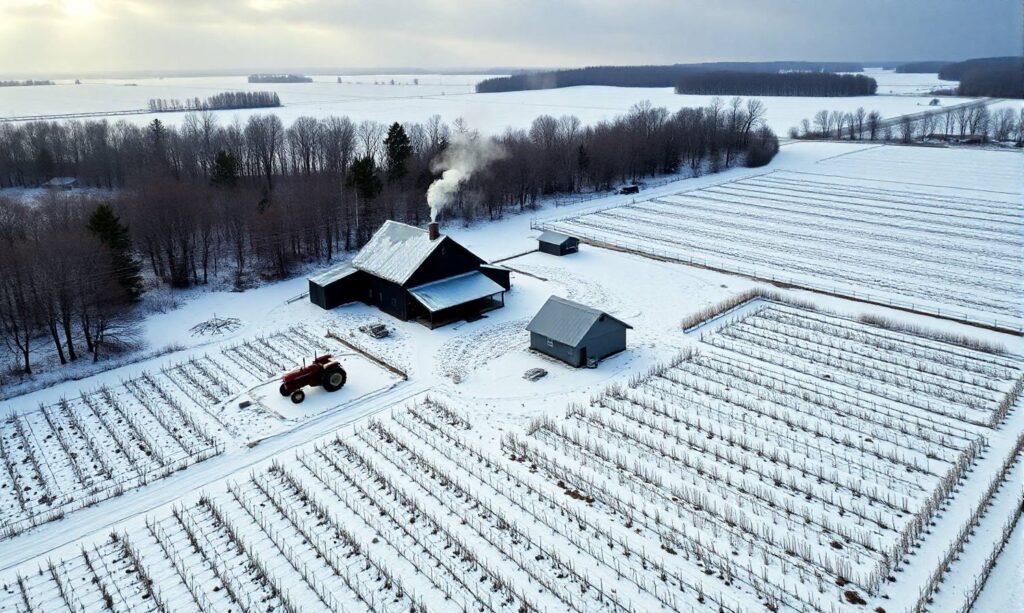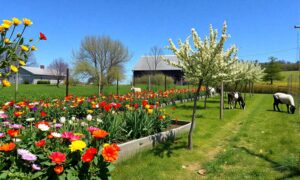
Winter can be a tough season for anyone, but when you’re preparing to winterize a homestead, it brings a whole new set of challenges. Winterizing a homestead isn’t just about staying warm—it’s about ensuring your home, livestock, and land are all ready to handle the cold months. With the right strategies, you can keep your property safe, productive, and comfortable, no matter how harsh the winter weather gets.
Insulating and Winterizing Your Home on a Homestead
When you winterize a homestead, insulating your home is the first step. This is crucial for both your comfort and your energy bills. By keeping the cold out and the warmth in, you can enjoy a cozy home while saving money on heating costs.
How to Insulate Your Rural Home for Winter
To effectively winterize a homestead, start by focusing on areas where heat loss is most significant. Begin with your attic, which is often the biggest culprit for heat loss. Adding a thick layer of insulation to your attic floor can prevent warm air from escaping. If your walls and floors aren’t well-insulated, now is the time to upgrade. Insulation options include fiberglass batts, foam boards, and even blown-in cellulose, each offering different benefits depending on your home’s structure.
Windows and doors are also major sources of drafts. Installing storm windows is an excellent way to add an extra layer of protection against the cold. Additionally, applying weatherstripping around doors and windows seals gaps where heat might escape, ensuring your home remains warm throughout winter.
For those in particularly harsh climates, consider investing in insulated curtains or window quilts. These can significantly reduce heat loss during the coldest nights. Also, don’t overlook the small gaps around your electrical outlets and switch plates—installing foam gaskets behind them can help prevent cold air from sneaking in.
Essential Tasks to Winterize Your Homestead
Winterizing a homestead also involves essential tasks like ensuring your heating system is prepared for the cold months. Whether you have a furnace, wood stove, or heat pump, make sure it’s serviced and ready to work efficiently during the coldest periods. Changing the air filters and checking for any blockages in the vents can improve the system’s efficiency.
Don’t forget about your water pipes. In rural areas, frozen pipes are a common issue. To prevent this, insulate any exposed pipes in your basement, attic, or crawl spaces. You might also consider installing heat tape on pipes that are particularly vulnerable to freezing. Additionally, draining outdoor faucets and irrigation systems will help prevent ice blockages that could cause bursts.
Finally, stock up on essentials like firewood, salt for icy walkways, and a backup power source like a generator. These supplies will help you stay prepared for any winter emergencies. It’s also wise to check the roof and gutters. Clear any debris that could cause ice dams, which are notorious for damaging roofs and causing leaks inside your home.
Protecting Livestock During Winter on a Homestead
A crucial part to winterize a homestead is ensuring that your livestock is well-protected and cared for during winter. Managing livestock during winter is a critical task that requires both preparation and ongoing care to keep your animals safe and comfortable.
Building and Maintaining Shelters for Livestock in Winter
When you winterize a homestead, creating safe and warm shelters for your livestock is imperative. If you already have barns or stables, now is the time to inspect and repair them. Look for leaks in the roof, drafts around doors, and any weak spots in the structure that could collapse under heavy snow.
If your homestead lacks permanent structures, temporary shelters such as hoop houses or tarped areas can suffice in milder climates. These should be sturdy enough to withstand wind and snow while providing adequate ventilation to prevent moisture buildup, which can lead to respiratory issues in animals.
Bedding is another crucial aspect of winter livestock care. Provide plenty of straw or wood shavings to keep animals warm and dry. Regularly check and replenish bedding to maintain a clean and comfortable environment. Also, consider investing in heated mats or pads, especially for animals that are more susceptible to cold.
Ensuring a Reliable Water Source in Freezing Conditions
Water is essential for livestock, but in freezing temperatures, it can be challenging to keep it available. Heated waterers or stock tank heaters are excellent solutions to prevent water from freezing. These devices maintain a constant water temperature, ensuring your animals can drink freely throughout winter.
If you’re using unheated water sources, check them multiple times a day to break the ice and replenish the water. Another option is to insulate water troughs with straw bales or foam board to slow down the freezing process.
Additionally, it’s vital to keep an eye on your animals’ water intake. Cold weather can reduce the desire to drink, leading to dehydration, so ensuring easy access to fresh water is crucial. In more severe conditions, you might consider adding electrolytes to the water to encourage drinking and ensure your animals stay hydrated.
Managing Snow and Ice on a Homestead
Managing snow and ice is another significant aspect when you winterize a homestead. With the right tools and strategies, you can keep your property safe and accessible, no matter how much snow falls.
Essential Tools for Snow and Ice Management
When living on a homestead year-round, having the right snow and ice management tools is a must. A heavy-duty snow shovel or snow blower is essential for clearing driveways, walkways, and paths to outbuildings. If you have a larger property, consider investing in a tractor with a snowplow attachment to clear extensive areas more efficiently.
For managing ice, sand and salt are your best friends. Spreading a mixture of both on walkways and driveways can help prevent dangerous slips and falls. However, use these substances judiciously to avoid damaging your concrete and harming nearby plants.
If you’re dealing with icy steps or porches, de-icing products can be applied directly to these surfaces. Keep a stockpile of these products to ensure you’re always prepared for sudden icy conditions.
For those with longer driveways or private roads, having a snow fence can be invaluable. A snow fence helps control where the snow piles up, reducing the amount of snow that drifts across your pathways and driveways.
Creating a Snow Removal Plan for Your Homestead
A snow removal plan is crucial for maintaining accessibility when you winterize a homestead. Start by identifying the areas that need to be cleared first, such as driveways, paths to barns or stables, and any areas where vehicles need to access regularly.
If you use a snowblower or plow, plan your routes to avoid creating large snow piles that could block access to other parts of your property. Consider where you’ll push the snow—piling it in areas where it won’t melt and refreeze into ice patches is important for safety.
Additionally, maintaining your equipment is key. Before winter hits, make sure your snowblower, plow, or tractor is in good working condition. Keeping spare parts on hand, like belts or shear pins for a snowblower, can prevent downtime during a storm.
For those with significant acreage, you might consider contracting with a snow removal service for the largest areas, while handling the smaller, more delicate areas yourself. This can save time and ensure that your property remains accessible even during heavy snowfall.
Winter Maintenance for Trees and Landscaping on a Homestead
Winter isn’t just hard on your home and livestock; it can also take a toll on your trees and landscaping. Proper preparation and maintenance can protect your plants and ensure they bounce back in the spring.
Protecting Trees and Shrubs from Winter Damage
Living on a homestead year-round means you likely have a variety of trees and shrubs that need protection during the winter. Start by inspecting your trees for any dead or weakened branches that could snap under the weight of snow and ice. Pruning these branches before winter reduces the risk of damage.
For shrubs and smaller trees, consider wrapping them in burlap or using protective coverings to shield them from harsh winds and heavy snow. Mulching around the base of trees and shrubs helps to insulate the roots and retain moisture, which is essential during the dry winter months.
If you have young or newly planted trees, staking them can prevent them from being uprooted by strong winds. Be sure to remove any tree wraps or coverings in early spring to allow for proper growth.
Additionally, for areas prone to heavy snowfall, you might want to set up temporary supports for more delicate trees and bushes. This will help them withstand the weight of accumulated snow and prevent branches from snapping under the pressure.
Maintaining Your Lawn and Garden Beds in Winter
While your lawn and garden beds are dormant during winter, they still need some attention. Raking up any remaining leaves and debris before the first snowfall can prevent mold and mildew from developing, which can damage your grass and plants.
If you have perennial plants, cutting them back and covering them with a layer of mulch will protect them from the cold and help them come back strong in the spring. Raised garden beds should also be mulched or covered with straw to protect the soil from freezing and thawing cycles, which can disrupt plant roots.
Additionally, keeping an eye on snow buildup around trees and garden beds is important. While snow can insulate plants, too much of it can crush shrubs and small trees. Gently removing excess snow with a broom can prevent damage.
For those with a passion for gardening, consider starting a winter garden indoors. You can grow herbs, leafy greens, and other cold-tolerant plants inside, giving you fresh produce even in the dead of winter. This not only adds to your winter food supply but also keeps your green thumb active during the colder months.
Planning for Winter Emergencies on a Homestead
Even with the best preparation, winter emergencies can still happen. From power outages to severe storms, being ready for the unexpected is a key part of winterizing a homestead.
Creating an Emergency Kit for Your Rural Homestead
An emergency kit is essential for anyone living on a homestead year-round. Start by assembling basic supplies like non-perishable food, water, and a first-aid kit. Include items like flashlights, batteries, and a weather radio to stay informed during power outages.
If you rely on well water, a backup generator is crucial to keep the pump running during an outage. Make sure you have enough fuel to last through a prolonged power cut.
Additionally, consider adding extra blankets, warm clothing, and a supply of firewood if you have a wood-burning stove. These items can help keep you warm if the heating system goes down.
Don’t forget about your vehicles. Make sure each one has an emergency kit, including a blanket, flares, and basic tools. Also, keep your fuel tanks topped up—an empty tank can be a serious problem if you get stranded during a storm.
Preparing for Winter Storms and Power Outages
Winter storms can quickly turn dangerous, especially in rural areas where help may be far away. Having a plan in place before a storm hits is vital for safety.
Start by staying informed about the weather. Use weather apps or a NOAA weather radio to monitor incoming storms and prepare accordingly. Before the storm arrives, secure loose items around your property that could become projectiles in high winds.
If a power outage is likely, charge your mobile devices and keep your emergency kit accessible. During the storm, avoid unnecessary travel and stay indoors as much as possible.
Finally, after the storm, check your property for damage. Look for downed trees, damaged fences, or issues with your home’s roof and siding. Address these issues promptly to prevent further damage.
Consider establishing a communication plan with neighbors. In rural areas, neighbors often rely on each other during emergencies. Knowing who to contact and having a system in place for checking in can be a lifesaver when roads are impassable or power lines are down.
Conclusion
Winterizing a homestead involves a lot of work, but with the right planning and effort, you can ensure that your home, land, and livestock remain safe and well-maintained throughout the cold months. From insulating your home to protecting your animals and managing snow, each step you take now will make winter living on your homestead much more comfortable and manageable.
If you’re ready to take on the winter season, explore our other resources for more tips and tricks on winterizing a homestead year-round. Sign up for our newsletter to stay updated with seasonal advice and guides!
FAQs
- What is the most important step to winterize a homestead? Insulating your home and preparing your heating system are crucial for staying warm and energy-efficient during winter.
- How can I protect my livestock during winter? Provide well-insulated shelters and ensure a reliable water source with heated waterers to keep your animals safe and healthy.
- What tools do I need for snow removal on a large property? A snow blower, snow shovel, and tractor with a plow attachment are essential for managing snow on a homestead.
- How do I prepare trees and shrubs for winter? Prune dead branches, wrap young trees in burlap, and mulch around the base to protect roots from the cold.
- What should I include in an emergency kit for winter? Include non-perishable food, water, a first-aid kit, flashlights, batteries, and a backup generator to stay prepared for power outages.
- How can I prevent pipes from freezing on my rural homestead? Insulate exposed pipes, use heat tape, and drain outdoor faucets to prevent freezing during cold spells.
- What are the best materials for insulating a rural home? Fiberglass batts, foam boards, and blown-in cellulose are all effective insulation materials for keeping your home warm in winter.
- How can I maintain my lawn during winter? Rake leaves, cut back perennials, and mulch garden beds to protect your lawn and plants from winter damage.
- What should I do before a winter storm hits? Secure loose items, charge devices, and stock up on supplies to stay safe during a winter storm.
- How do I manage ice on walkways and driveways? Use sand or salt to prevent slips and falls, and keep de-icing products on hand for icy conditions.




